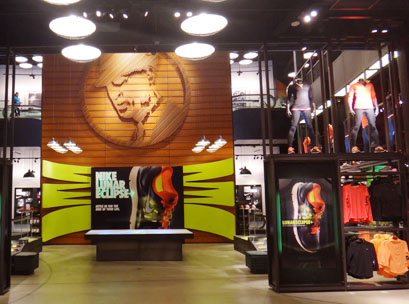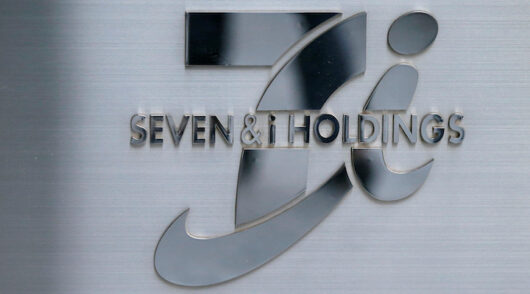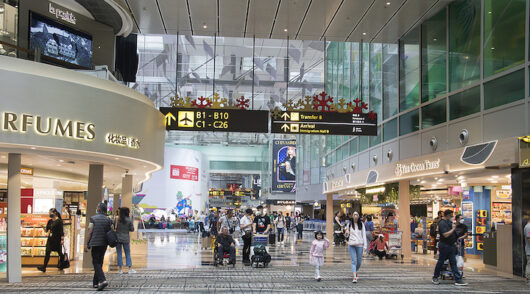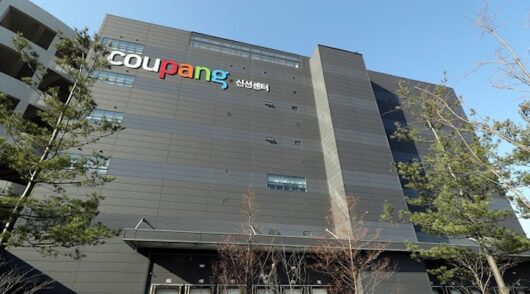The most innovative and disciplined retailer on the planet isn’t a retailer at all, in my opinion.
It’s a manufacturer brand. Which brand? I’ll give you a one-word clue that sums up both their creativity and agility: “Swoosh”. (Got it? I thought so.)
One of the biggest changes to retail in the 21st century has been the rise of the brand marketer “going vertical”. Names like Apple have reinvented the game, and traditional retailers have had to play catch up.
But Nike takes it to a whole new level. In fact, they take it to several new levels, because Nike retail works to a pyramid framework, with their flagship store concept at the peak, and store-in-store application at the base. In between are all their many and varied formats, inexorably linked by a strong brand DNA thread.
Travelling around the world in the last few weeks on the Westfield World Retail Study Tour, I was fascinated to see the Nike brand in just some of its iterations:
Nike Store Flagships.
These are pure brand statements, showrooms for all things Nike, in some of the most prominent and expensive real estate locations in the world, like Harajuku in Tokyo, Oxford Street in London, Caesars Palace in Las Vegas and the Champs Elysees in Paris. All are big, glossy and impressive, with features from running tracks to Nike iD studios, which allow customers to design their own running shoes.
Every store is different, but they are all unmistakably Nike; richly (but subtly) telling the story of the brand and using design features that reference athletics – sports lockers, gym mats, “bib” numbers from running events, rubber running surfaces, bleachers, mannequins “on the move”.
Nike Pop Ups & Premium Store-in-Stores
These stores are as much brand statements as the flagships, but far more focused, designed to appeal to niche groups and early adopters. In the Boxpark “permanent pop up” mall in Shoreditch in London, Nike has two such concepts – a “Fuel Station” to launch its Fuel Band product, and a Custom iD store. In fashion-forward retailers like Colette in Paris, and 10 Corso Como in Milan, Nike spotlights high-end designer collaborations, such as Tom Sachs’ NikeCraft project.
Nike Brand and Category Stores:
These are situated in A-level malls around the world, and follow the same “hub and spoke” formula employed by the likes of Apple. The flagship is the “hub”, the brand or category store is the “spoke” – a cut-down version of its big brother, but retaining the same distinctive design cues.
Some showcase the breadth of Nike apparel, shoes and accessories, others, like the store at Palo Alto in California are sports specific, in this case a Nike Running Store. All have an element of “community”, like run clubs that leave from the store.
Nike Studio Stores
These outlets slice the Nike brand in a different way, eg Nike iD Studio Stores, dedicated to customisation of product. Same brand soul though.
Nike Factory Stores
More rational and functional in design than the regular retail stores, Nike’s factory outlets still carry the look and feel of the Nike brand, just stripped down.
Nike Store-in-Stores
In branded sports retailers all over the world, including Dick’s in the US and Rebel here, Nike has distilled its essence to a store-in-store format. In these spaces, you can still clearly see echoes of the Nike flagships.
Perhaps I shouldn’t be surprised that Nike does retail so well… and so consistently. After all, retail is where they got their start. In the 1960s, Nike began by selling shoes from the back of a station wagon at track meets in Oregon.
In researching this piece, I came across an interview with Nike retail chief Jeanne Jackson in the US magazine The Hub. Jackson reveals how important what they call “direct-to-consumer” is to Nike.
“Retail is the place where we come face-to-face with consumers and tell them our story directly and unfiltered, whether it’s a brick-and-mortar store or a digital store,” enthuses Jackson. “The stores all have slightly different centres in terms of their product offerings, but they share a common ethos around performance, youthful energy and all things that are Nike.”
It’s important to the bottom line too. Nike stores make up at least 25 per cent of the brand’s US$21 billion annual turnover.
All retailers can learn from Nike… and other brands that have taken their message straight to consumers. It requires a shift in attitude, a re-think if you like. Think like a brand, not like a retailer.
Think like a marketer, not like a merchant.
Jon Bird is CEO of specialist retail marketing agency IdeaWorks. Email Jon. Read Jon’s blog. On Twitter: @thetweetailer






